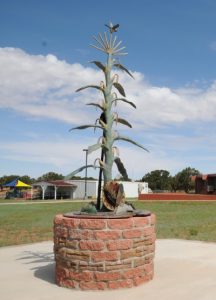SevereWeather
Severe Weather Watch: Conditions are favorable for severe weather. Severe Weather Warning: Severe weather is occurring and on course or has been sighted nearby: Shelter-in-Place should be taken immediately.


GENERAL GUIDELINES
- Monitor Emergency Alert Systems (radio, text alerts, HCC website, national Weather service).
- Closings or other restrictions of travel can be monitored through the HCC website, radio and television, and emergency text alerts.
- Review Shelter-in-Place procedures.
- Bring all persons inside buildings.
- Close windows and blinds.
- Review shelter/evacuation procedures and loca-tion of safe areas.
- Review “duck & cover” procedures. (Crouch down on elbows and knees with hands over the back of the head.)
FLOODING
- If it is safe to do so, turn off or disconnect electrical devices in the flood area.
- Protect or remove valuable property that is susceptible to water damage.
- Close doors and seal openings to minimize the spread of water.
- Remain in a safe adjacent area to direct response personnel to the site and others away from the site.
- If flooding liquid is contaminated, the area must be secured.
- If in an automobile, do not try to cross a flooded roadway.
HEAT ADVISORY
Heat can create serious health problems. The best defense against heat-related illness is prevention.
- Stay cool.
- Drink plenty of fluids but avoid drinks with alcohol, caffeine or a lot of sugar.
- Start drinking fluids before going out into the heat.
- Wear cool clothing.
- Monitor outdoor activities.
Heat Illness: symptoms of heat illness include heavy sweating, muscle cramps, weakness, dizziness, nausea, weak but rapid pulse, and headaches. people with these symptoms should find shade, drink water slowly and make sure there is good ventilation.
Heat stroke: If fluids are not replaced soon enough, heat stroke can follow causing extremely high body temperature, red and dry skin, rapid pulse, confusion, brain damage, loss of consciousness and death. To help a person showing severe symptoms, get the victim into shade, call for emergency medical services and start cooling the person immediately with cool water or by fanning.
SEVERE THUNDERSTORM WARNING
- Move all staff and students indoors.
- Be prepared to shelter-in-place.
- Follow lab safety guidelines (for applicable lab personnel).
- Do not touch downed power lines or any objects that are in contact with downed lines.
- Look out for broken glass and exposed nails.
- Use extreme caution when entering damaged structures.
SEVERE THUNDERSTORM WARNING
- Immediately end all experiments in progress and halt the use of chemicals, radiological or biohazard agents.
- Radioactive, chemical and biological hazards should be stored in a secure compartment and/or sealed.
- The following should be protected with adequate shielding:
- Solvents in flammable cabinets
- Corrosives in acid/base cabinets
- Radioactive materials in their shipping container with:
- Adequate shielding
- Biologicals in incubators
- Dry chemicals with wooden or metal doors
- Hazardous materials should not be left on counter tops, open shelves or floors.
- Shut off gas (for applicable lab personnel).
- Small breakables should be emptied and stored.
- Shelve and secure all glassware, microscopes, etc.
- Protect all equipment in areas with windows from hazards associated with broken glass, driven rain and wind. Leave all floor and counter space clear of equipment, papers, and chemicals.
TORNADO WATCH
- Conditions are right for tornadoes to develop.
- Be prepared to take cover.
TORNADO WARNING
- A funnel cloud has been sighted or indicated in the vicinity.
- Take cover.
IN A TORNAD0
- Take shelter in the interior area of the lowest level of the building. Avoid windows and large, open rooms. If possible, get under a sturdy desk or table.
- Protect your head with your arms.
- If caught outside, lie flat in the nearest ditch, ravine or culvert with hands and arms shielding your head.
- If in an automobile, abandon the vehicle and follow guidelines for outdoor shelter.
- Information on tornado watches and warnings is available.
WINTER STORM (SNOW/ICE/WIND)
- Be aware of slip-and-fall hazards associated with wet floors and icy surfaces.
- Wear several layers of loose-fitting clothing, mittens, a hat and a face cover when outdoors.
- Stay dry.
- Be extra cautious in the wind. A strong wind, even in only moderately cold weather, can cause a wind chill far below freezing.
- At the first signs of possible frostbite, redness or pain in any skin area, get out of the cold or protect any exposed skin.
- Watch for hypothermia symptoms: confusion, drowsiness, slurred speech, a drop in blood pressure, shallow breathing and a pinkish tint to the skin.
- Anyone with hypothermia symptoms is in immediate danger and should receive medical help right away.
EARTHQUAKE
If you are inside:
- Duck under a desk or sturdy table or brace in adoorway.
- Stay away from windows, appliances, and heavy objects that could fall on you (bookcases, file cabinets, heavy mirrors, etc.).
- Do not use elevators.
- Stay indoors until shaking stops, then cautiously move outdoors.
If you are outside:
- Move into open space away from electrical lines, trees and buildings if possible.
- Or, duck into a doorway to avoid falling debris.
If you are driving:
- Pull over to the side of the road but do not stop on or beneath bridges or near power lines or large highway signs.
Afterward, be prepared for aftershocks and report any gas leaks or electrical problems to Maintenance Department (928-724-6772). If gas leaks are possible, do not use open flames, electric switches or appliances.

